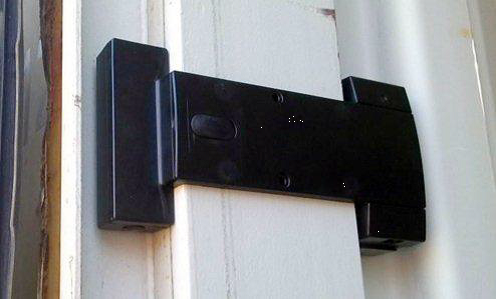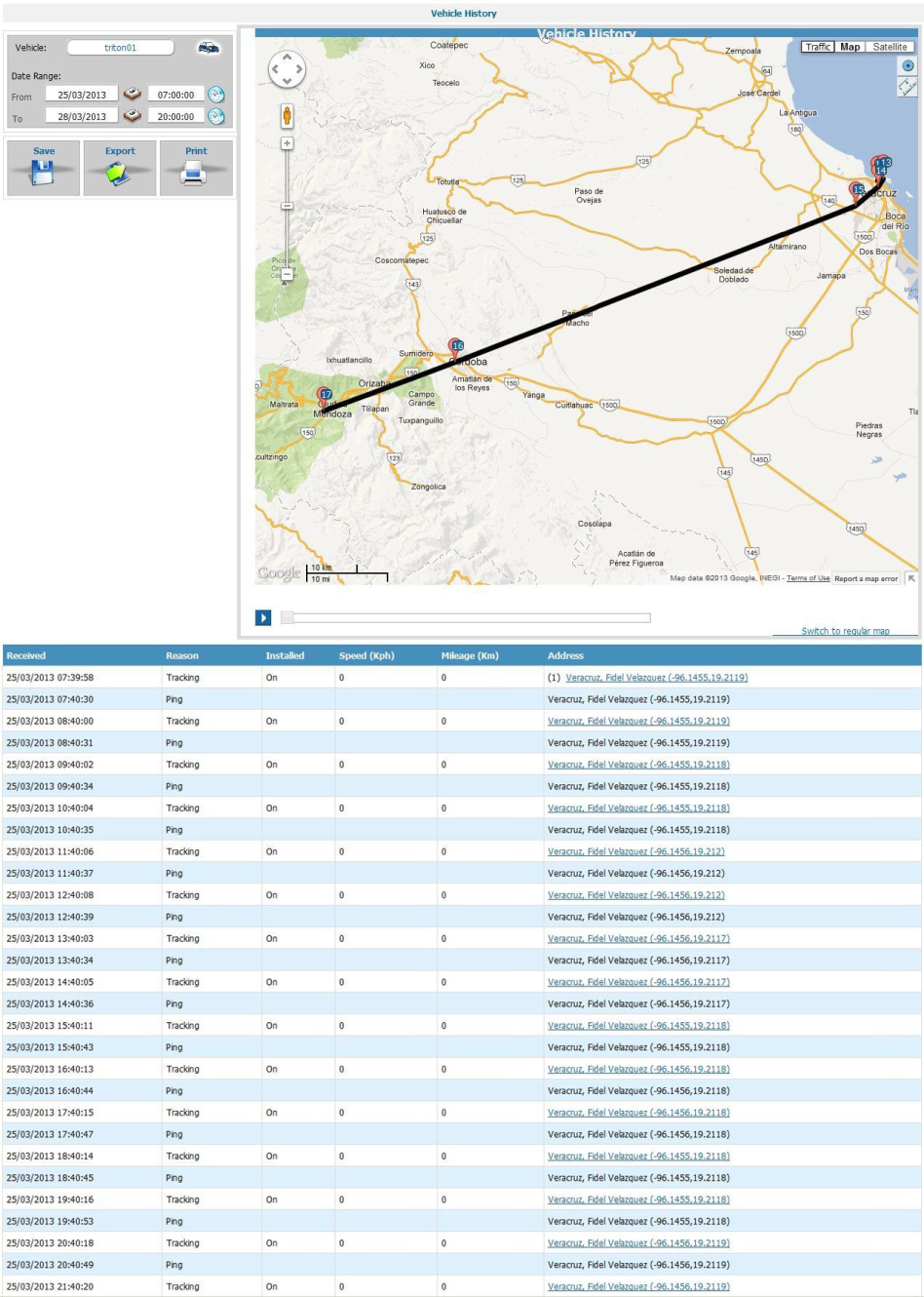GPS monitoring of freight containers
Vehicle monitoring systems and GPS equipment breed almost as fast as smartphones. But the transport is different, and it would be good to have devices that correspond to its appearance. Not so long ago, one such copy came into my hands, which I would like to briefly tell you about. Quite easy to use solution from Starcom Systems, which allows you to monitor the movement of containers. Called Triton.
The device is designed specifically for containers and only for them. It records any hacking attempts, deviations from routes, temperature changes and ... the list goes on and on. First things first.
Triton is installed in a few seconds, as the system is sharpened specifically for the container. It has 2 parts connected by a jumper, which allows you to move the antenna part to the outer side of the container (the outer part is dustproof and moisture resistant), and all the electronics are inside the container.
')


Packaging consists of:
This is how the container doors look in Triton's arms.

Now what the device consists of:

The set of sensors is standard: a light sensor, an accelerometer and a temperature sensor (from -127 ° C to 127 ° C).
Specifications:
I liked the fact that the device itself goes into standby mode when it is possible, which saves battery power.
By default, the device transmits data via GPRS, and SMS is used as a backup channel. You can configure regular tracking data transmission intervals, which determine how often the device will transmit status information.

You can adjust various parameters of the equipment.

Triton is integrated with various monitoring services, which, in my opinion, is an undoubted advantage. You can use both the manufacturer’s system and third-party solutions, such as Wialon .
If you use the device with the starcom online system, then there is the following set of functions:
Now go to the reports. You can set the report settings “on demand” or “on schedule”. The report itself is generated for the last 30 days. You can create the following types of reports. Work Hours, Work Hours Group, Work Hours Group Summary, History, History - Technical, Violations, Live Status, Events, Perimeter Entry, Transmit Reasons, Monitored events, Stop Hours.
So, for example, the report for 1 one day and a certain period of time will look. The report includes a map area and tracking data area. In the map area there is a map of the territory where the device with its movements is located. The tracking data area lists device tracking data.

To summarize, with Triton we have a set of quite useful functions: programmable events, geographic events, transportation distance alerts and, in fact, online tracking without sending additional commands.
From communications we have: four-frequency GSM, DNS support, TCP protocol connection, backup server, compact protocol for saving traffic and its encryption (if someone suddenly needs this level of security), ZigBee connection.
Well, now the fun part. At what price the device is sold to the manufacturer is unknown to me, but retailers offer Triton an average of $ 560 each. Given that the cost of the goods can be ten times more, the option is quite good. And what do you think?
The device is designed specifically for containers and only for them. It records any hacking attempts, deviations from routes, temperature changes and ... the list goes on and on. First things first.
Triton is installed in a few seconds, as the system is sharpened specifically for the container. It has 2 parts connected by a jumper, which allows you to move the antenna part to the outer side of the container (the outer part is dustproof and moisture resistant), and all the electronics are inside the container.
')


Packaging consists of:
- Triton device itself;
- battery;
- charging;
- RS232 cable with USB connectors.
This is how the container doors look in Triton's arms.

Now what the device consists of:
- Central bracket;
- Battery compartment, processor, GSM and GPS modules (system core);
- Antenna compartment;
- Light sensor;
- Door button;
- Operation button;
- Mini USB output port;
- Install button;
- Magnets.

The set of sensors is standard: a light sensor, an accelerometer and a temperature sensor (from -127 ° C to 127 ° C).
Specifications:
| Power supply | Voltage | 3.7 V |
|---|---|---|
| Temperature | During operation At storage | -20 - 60 ° C -40 - 85 ° C |
| Operating Humidity | Up to 90% | |
| Dimensions | 195 x 96 x 40 mm | |
| Cellular modem | GSM | Four-band (850, 900, 1800, 1900). Built-in antenna |
| Network | Data transfer | GPRS and SMS |
| Messages | SMS GPRS | Encrypted protocol TCP / IP over PPP |
| GPS | Receiver and antenna Protocol Positioning accuracy Navigation refresh rate Navigation method Time to first positioning (TTFF) | Interior NMEA (binary format) Position: 10m CEP (50%) Speed: 0.2 m / s (50%) 1 sec (default) <> br Solution “All satellites in sight” Solution "2 satellites" Hot start: 2 sec Warm start: 10 sec Cold start: 50 sec |
| Processor power | Static RAM Non-volatile memory Flash memory | 128 KB 34 KB 2048 kb |
| Inputs | Button Light sensor | 3 one |
| Battery | Type of Capacity | Lithium ion 5200 mAh |
| Power consumption | Sleep / Standby GPS only GPRS only GPS and GPRS | 0.05 mAh 75 mAh 100 mAh 165 mAh |
| Com port | RS232 | 115,200 bps (default) |
I liked the fact that the device itself goes into standby mode when it is possible, which saves battery power.
By default, the device transmits data via GPRS, and SMS is used as a backup channel. You can configure regular tracking data transmission intervals, which determine how often the device will transmit status information.

You can adjust various parameters of the equipment.

Triton is integrated with various monitoring services, which, in my opinion, is an undoubted advantage. You can use both the manufacturer’s system and third-party solutions, such as Wialon .
If you use the device with the starcom online system, then there is the following set of functions:
- Home - a list of recently called devices, including their location.
- Resources - device and customer data management.
- Plans - create and administer alerts and events.
- Monitor - tracking events and alerts from the device.
- Map - the current location of the device on the map.
- Reports - reports on device activity.
- Profile - setting user properties.
- Help - tutorials and knowledge base.
Now go to the reports. You can set the report settings “on demand” or “on schedule”. The report itself is generated for the last 30 days. You can create the following types of reports. Work Hours, Work Hours Group, Work Hours Group Summary, History, History - Technical, Violations, Live Status, Events, Perimeter Entry, Transmit Reasons, Monitored events, Stop Hours.
So, for example, the report for 1 one day and a certain period of time will look. The report includes a map area and tracking data area. In the map area there is a map of the territory where the device with its movements is located. The tracking data area lists device tracking data.

To summarize, with Triton we have a set of quite useful functions: programmable events, geographic events, transportation distance alerts and, in fact, online tracking without sending additional commands.
From communications we have: four-frequency GSM, DNS support, TCP protocol connection, backup server, compact protocol for saving traffic and its encryption (if someone suddenly needs this level of security), ZigBee connection.
Well, now the fun part. At what price the device is sold to the manufacturer is unknown to me, but retailers offer Triton an average of $ 560 each. Given that the cost of the goods can be ten times more, the option is quite good. And what do you think?
Source: https://habr.com/ru/post/234293/
All Articles